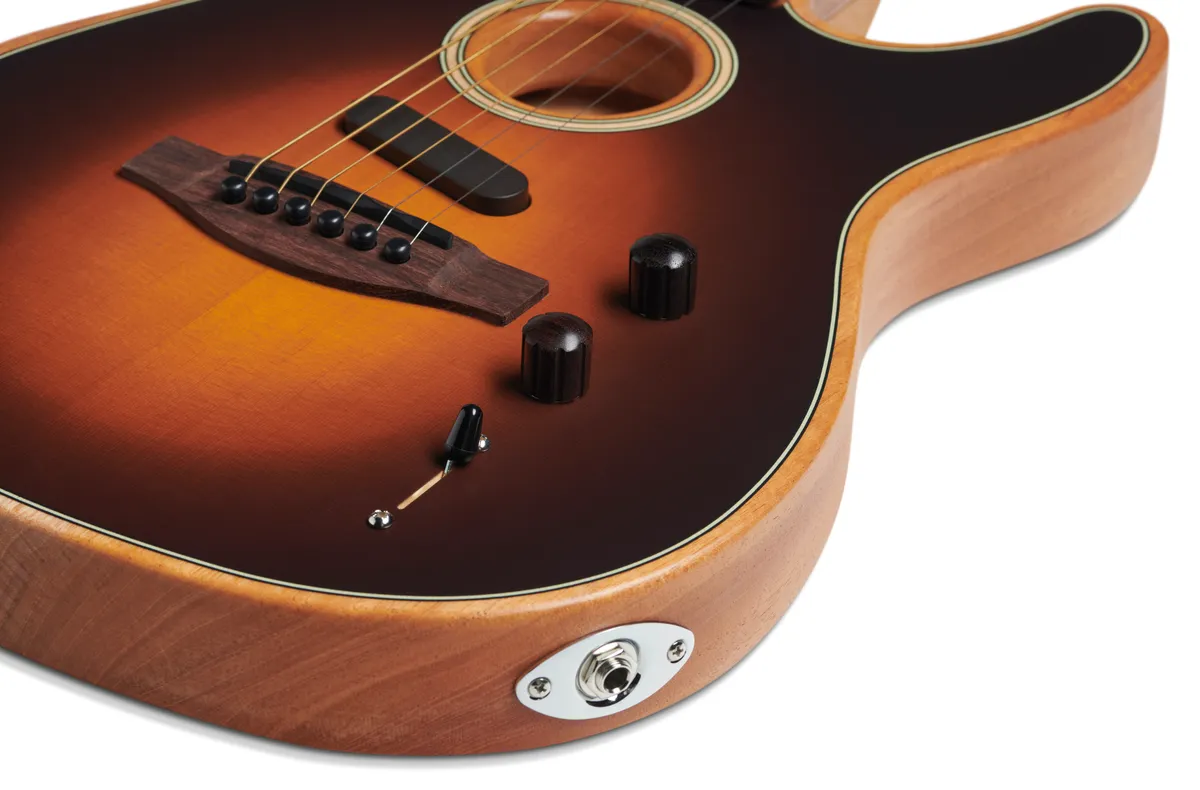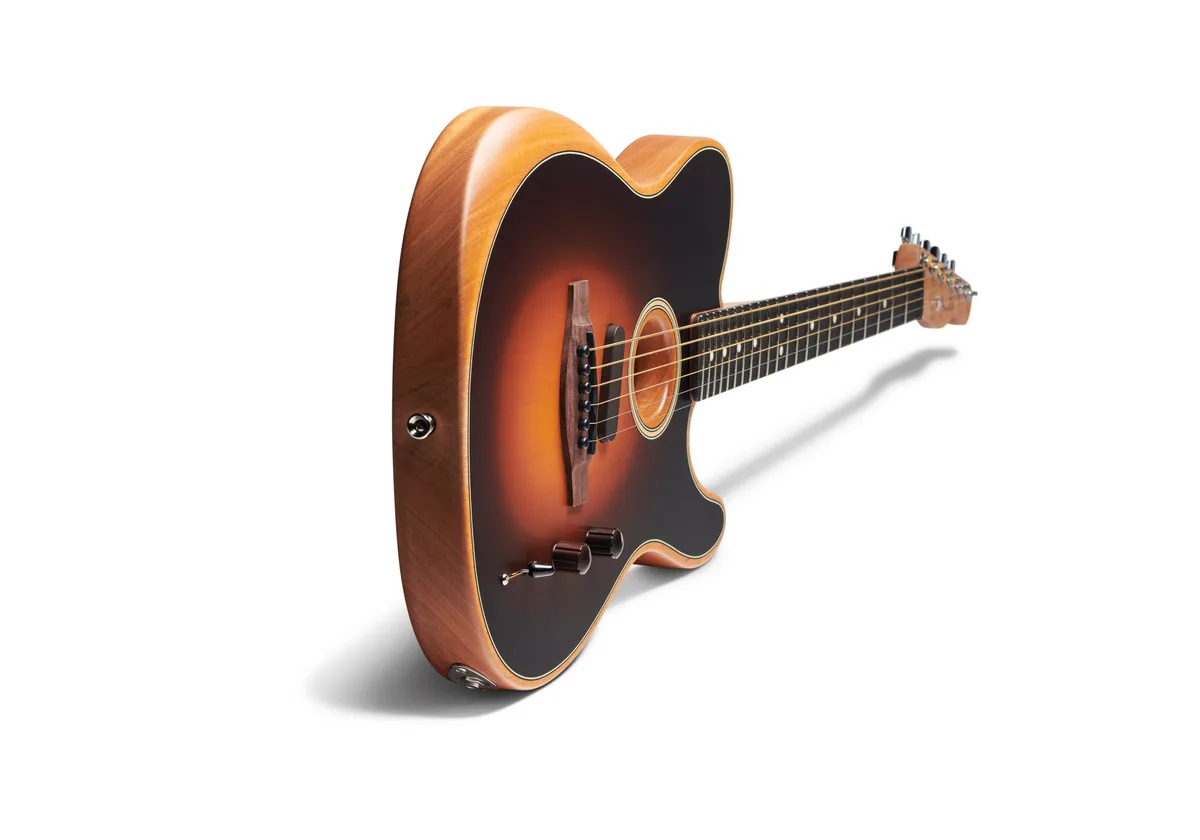SQUIRREL_13099573
It’s fair to say that we guitarists can be a bit of an old-fashioned bunch. The three most popular electric guitars currently on the market – Fender’s Telecaster and Stratocaster, and Gibson’s Les Paul – were all designed in the early fifties and have gone through very few changes since. And as beautifully designed and iconic as they are, they are still essentially just lumps of wood embedded with magnetic pickups with some strings stretched over them.
It’s little surprise then that Fender turned a few heads back in 2019 when they launched the American Acoustasonic Telecaster. This was a guitar unlike any before it. Fully hollow but with the shape of a solid body Telecaster. Strung with bronze acoustic strings but with a slim electric-style neck and low action. And fitted with a high-tech system of three pickups designed to give the player access to tones ranging from the deep boom of an acoustic dreadnought to the classic raunchy Telecaster twang.
While many were left scratching their heads at first, the instrument has gradually built up something of a cult following and has been seen in the hands of everyone from sensitive singer/songwriters to more out-there indie rockers.
But there was just one slight issue: the price tag. Getting your hands on one in the UK will set you back £1749 if you pay full retail price. That’s a fair old chunk of change to stump up for any guitar, even one as versatile as the Acoustasonic.
That’s where the newly launched Acoustasonic Player Telecaster, or APT, comes in. It’s a stripped-down Mexican-made version of its older American-made sibling with a significantly less wallet-walloping retail price of £1049.
Design and build
The APT is built in Fender’s cutting-edge facility in Ensenada, Mexico, and straight out of the gigbag it smacks of quality. The mahogany neck, back and sides are smooth and well finished, the lightly applied satin matte finish leaves the attractive grain of the solid sitka spruce top just visible, and the acoustic-style rosewood bridge and string pegs are a tasteful nod to the guitar’s hybrid identity.
Moving up to the other end of the 22-fret neck, we have a rosewood fingerboard, a set of narrow but tallish frets, a GraphTech Tusq nut, and a set of reassuringly smooth and solid Fender-branded tuners.

But of course, most of the innovation going on in the APT is hidden under the bonnet. As mentioned previously, the APT is a stripped-down version of the American Acoustasonic, and the key way in which the two instruments differ is in their pickup setups.
The APT model has a three-way voice selector, as opposed to the American Acoustasonic’s five-way, and two pickups, as opposed to the American model's three. The designers chose to forgo the Fishman Acoustasonic enhancer designed to pick up the vibrations of the guitar’s top - presumably to bring the cost down. This leaves the APT with a Fishman under-saddle transducer piezo and a specially designed Fender noiseless single coil.
In each of the positions a blend control allows you to select between two of six voicings that Fender have tuned specifically for the APT using digital signal processing tech they call the Acoustic Engine.
With the voice selector in position one we have the classic Telecaster bridge pickup tone when the blend knob is rolled all the way back and a fat Telecaster bridge pickup tone when it is rolled all of the way forward. In between these are a countless number of blends as you roll the knob back and forth.
Position two gives us the so-called 'Lo-Fi clean' tone on one side, which is essentially the straight up sound of the piezo, and 'Lo-Fi crunch' on the other, which is a crunchy beefed-up version of the same thing.
Finally, position three gives us the ‘acoustic’ sounds. We have a tone modelled on a small-bodied mahogany acoustic on one side and one modelled on a rosewood dreadnought on the other.
All of the tech going on inside the APT means it needs its own power source. This comes by way of a 9V battery tucked into a compartment on the instrument’s back. The more expensive American model has a built-in rechargeable battery that can be easily re-juiced via a micro-USB socket. It’s a minor quibble but what with the ubiquity of USB charging nowadays it does seem a bit old-fashioned to go the 9V battery route.
Playability and sound
Thanks to its light weight and ergonomic heel contour, the APT is incredibly comfortable to hold whether seated or standing. The ‘deep C’ profile neck is welcoming and sits easily in the hand and the 25.5” scale length will no doubt feel like home for any devoted Fender player. Along with the low action of our review model, the playing experience feel-wise was definitely more akin to a solid body electric guitar than a fully acoustic guitar.

Ours came strung with bronze acoustic guitar strings, which took a bit of getting used to. The guys at Fender say there’s no reason why you couldn’t string it up with the regular nickel set that you’d use on an electric, and I think this would be something worth experimenting with.
So how does it sound? Maybe I was expecting too much, perhaps due to the instrument’s high-tech, precision-engineered look, but I found the APT’s unplugged sound a bit underwhelming. Even when really digging in with a pick I think you’d struggle to get heard over all but the quietest of singers.
Although the APT’s unplugged sound doesn’t come close to the volume and projection of a fully acoustic guitar, you can still hear what you are playing comfortably enough to get in a bit of quiet practice, sketch out some song ideas, or, as I often found myself doing, plonk yourself on the sofa for a bit of evening noodling.
Plug the guitar into an amp, however, and it’s a whole different story. Starting with the pickup selector in position one you can instantly hear the classic Telecaster twang. Rolling the blend knob towards the fat setting gradually adds more oomph and grit until we find ourselves in overdrive territory.
Position two was my least favourite of the bunch. It just seems a bit plain and lacks the identity of the other settings. Having said that, I could perhaps see it being loved by a more ambient-style player that likes to layer pristine clean sounds with multiple effects. Maybe. Fender coyly describe the sound as ‘unique’ in the instruction manual, so it can’t just be me that finds this setting a touch difficult to get my head around.
Then finally, when we make our way to position three we have the acoustic modelling sounds. As you would expect, rolling the blend towards the small-bodied mahogany side gives a tighter, sweeter sound, while going the other way, towards the dreadnought side, adds space and low-end boom.
For my money both were a good deal more acoustic-sounding than any more ‘traditional’ electro-acoustic guitar I’ve played - those with bridge-mounted piezo transducers sound especially plasticky to my ear. I also found myself using the blend knob a lot more in this position than the others and was really quite surprised with some of the warm, natural-sounding tones I was able to dial in.
It’s likely that every player is going to have their own favourite settings but the novelty of effortlessly switching from blasting out crunchy Keith Richards licks one second and then fingerpicking some Greenwich Village 1960s-style folk songs the next, without having to pick up another guitar, put a big grin on this reviewer’s face.
Verdict
The Acoustasonic series occupies a genuinely unique place on the guitar store shop floor. To this end Fender market them as ‘true electric-acoustic hybrid guitars’. It’s difficult to argue with them, but seeing the Acoustasonics as a ’Jack-of-all trades’ type instrument isn’t really doing them justice in my opinion. They have their own feel, sound and identity.
At £1049 the APT is far from being cheap. But there’s no denying that it’s a well-made, great-sounding guitar that’s fun to play. Thanks to that I can definitely see it making its way into the hands of many guitarists looking for something a little bit different.
SQUIRREL_13099573
Other options
Fender American Acoustasonic Telecaster

The obvious other option, if you're not short of money, is to go for the APT's older sibling. There isn't much difference in the build quality and playability but you do have a good few more extra tonal options. Plus you're also paying extra for the street cred of owning a genuine American-made Fender guitar.
SQUIRREL_TEXT_13074039
Squier Paranormal Cabronita Telecaster Thinline

For a cheaper, more old-school option you could do a lot worse than this Squier Cabronita Thinline. It has a similar look and feel but its fitted with a pair of Fender-designed Alnico Jazzmaster single-coil pickups giving it a more electric-focused sound.